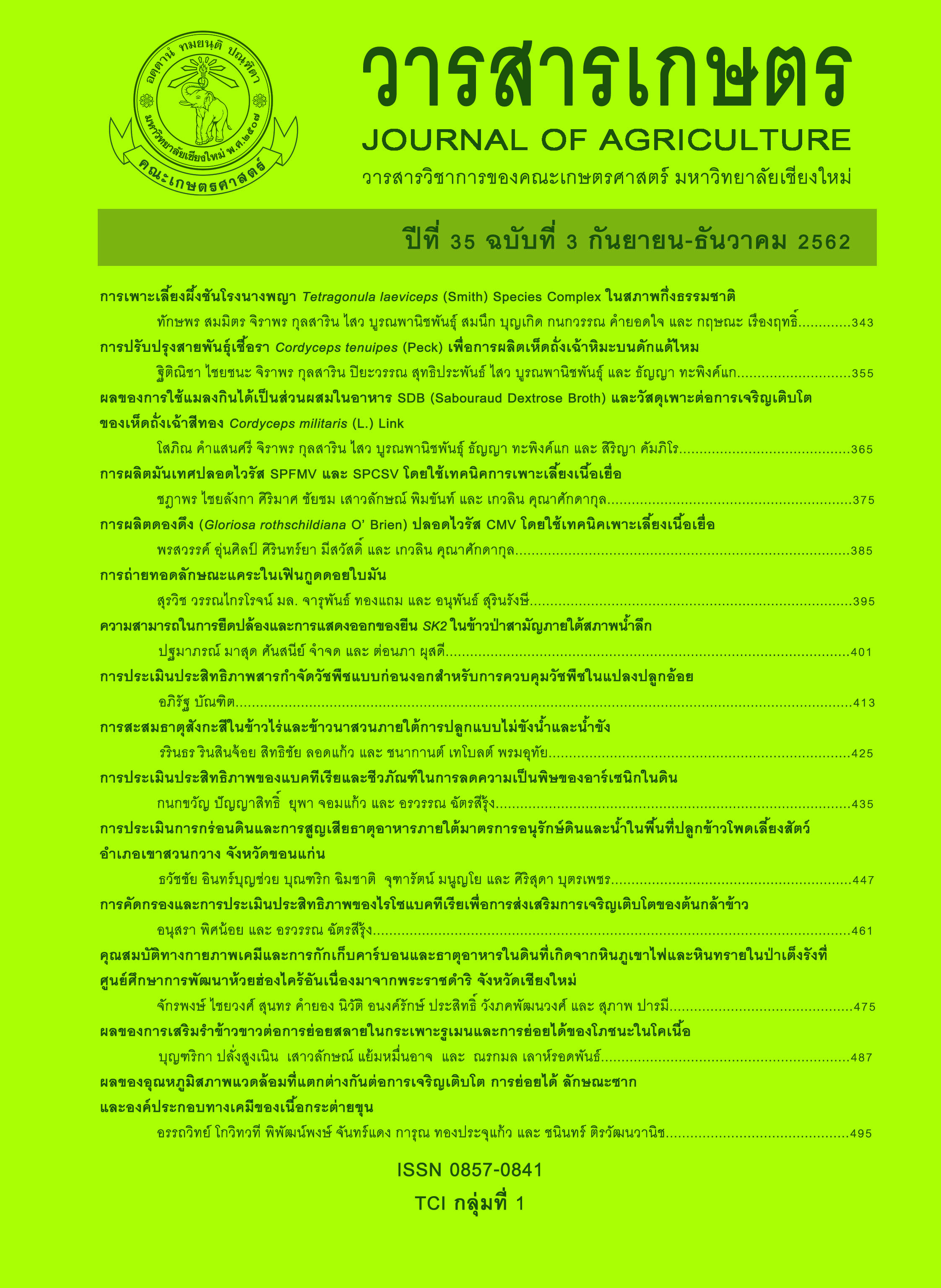Effects of Different Ambient Temperatures on Growth Performances, Digestibility, Carcass Traits and Meat Chemical Components in Fattening Rabbits
Main Article Content
Abstract
The study on growth performances, digestibility, carcass traits and meat chemical components of fattening rabbits between different environmental temperatures at housing was the objective of this study. Forty weaned New Zealand white rabbits were randomly separated and reared in an optimal controlled (OT) housing without heat stress environment (Temperature humidity index: THI=21.5-23.1) and an ambient temperature (AT) housing (opened housing) under a severe heat stress and wide temperature fluctuation during the day (THI=24.8-36.2). The AT group was lower in live weight, average daily weight gain, slaughter weight, hot carcass weight and cold carcass weight comparing to OT group (P<0.05), whereas the rabbits in AT group was higher in nutrient digestibility than the OT group (P<0.05). Moreover, higher proportion of water and lower nutrients were observed in the rabbit meat which lived under severe heat stress condition (P<0.05). Based on these results, the rearing rabbits under heat stress provided adverse consequences on productive performances and meat chemical components.
Article Details
References
AOAC. 2000. Official Methods of Analysis. 17th ed. Association of Official Analytical Chemists, Arlington. 2200 p.
Chiericato, G.M., C. Rizzi and V. Rostellato. 1993. Effect of genotype and environmental temperature on the performance of the young meat rabbit. World Rabbit Science 1: 119-125.
Dalle Zotte, A. and G. Paci. 2014. Rabbit growth performance, carcass traits and hind leg bone characteristics as affected by the sire breed, season, parity order and sex in an organic production system. Animal Science Papers and Reports 32: 143-159.
FAOSTAT. 2018. World rabbit production. (Online). Available: https://www.fao.org/faostat/en/#data/ QA (July 15, 2018).
Ghosh, S.K., A. Das, K.M. Bujarbaruah, A. Das, K.R. Dhiman and N.P. Singh. 2008. Effect of breed and season on rabbit production under subtropical climate. World Rabbit Science 16: 29-33.
Habeeb, A.A., A.I. Aboul-Naga and H.M. Yousef. 1993. Influence of exposure to high temperature on daily gain, feed efficiency and blood component of growing male Californian rabbits. Egyptian Journal of Rabbit Science 3: 73-80.
Hermes, I.H., B.M. Ahmed, M.H. Khalil, M.S. Salah and A.A. Al-Homidan. 1999. Growth performance, nutrients utilization and carcass traits of growing Californian rabbits raised under different ambient temperatures. Egyptian Journal of Rabbit Science 9: 117-138.
Kovitvadhi, A., P. Sanyathitiseree, L. Gasco and T. Rukkwamsuk. 2016a. Meat rabbit production in central, western and eastern Thailand: Social network and current status. pp. 961-964. In: Proceedings of the 11th World Rabbit Congress, Qingdao, China.
Kovitvadhi, A., L. Gasco, I. Ferrocino, L. Rotolo, S. Dabbou, V. Malfatto, F. Gai, P.G. Peiretti, M. Falzone, C. Vignolini, L. Cocolin and I. Zoccarato. 2016b. Effect of purple loosestrife (Lythrum salicaria) diet supplementation in rabbit nutrition on performance, digestibility, health and meat quality. Animal 10: 10-18.
Marai, I.F.M., A.A.M. Hebeeb and A.E. Gad. 2002. Rabbits’ productive, reproductive and physiological performance traits as affected by heat stress: a review. Livestock Production Science 78: 71-90.
Marai, I.F.M., M.S. Ayyat and U.M. Abd El-Monem. 2001. Growth performance and reproductive traits at first parity of New Zealand White female rabbits as affected by heat stress and its alleviation under Egyptian conditions. Tropical Animal Health and Production 33: 451-462.
Marai, I.F.M., M.S. Ayyat, H.A. Gabr and U.M. Abd El-Monem. 1999. Growth performance, some blood metabolites and carcass traits of New Zealand White broiler male rabbits as affected by heat stress and its alleviation under Egyptian conditions. Cahiers Options Méditerranéennes 41: 35-42.
Perez, J.M., F. Lebas, T. Gidenne, L. Maertens, G. Xiccato, R. Parigi-Bini, A. Dalle Zotte, M.E. Cossu, A. Carazzolo, M.J. Villamide, R. Carabaño, M.J. Fraga, M.A. Ramos, C. Cervera, E. Blas, J. Fernandez, L. Falcão-e-Cunha and J. Bengala Freire. 1995. European reference method for in vivo determination of diet digestibility in rabbits. World Rabbit Science 3: 41-43.
Pla, M., J. Fernandez Carmona, E. Blas and C. Cervera. 1994. Growth and some carcass traits of adult rabbits under high ambient temperature. World Rabbit Science 2: 147-151.
R Development Core Team. 2008. R: A language and environment for statistical computing. R Foundation for Statistical Computing, Vienna, Austria.
Rotta, P.P., I.N. Prado, R.M. Prado, J.L. Moletta, R.R. Silva and D. Perotto. 2009. Carcass characteristics and chemical composition of the Longissimus muscle of nellore, caracu and Holstein-friesian bulls finished in a feed lot. Asian-Australian Journal of Animal Sciences 22: 598-604.
Zeferino, C.P., A.S.A.M.T. Moura, S. Fernandes, J.S. Kanayama, C. Scapinello and J.R. Sartori. 2011. Genetic group × ambient temperature interaction effects on physiological responses and growth performance of rabbits. Livestock Science 140: 177-183.
Zeferino, C.P., C.M. Komiyama, S. Fernandes, J.R. Sartori, P.S.S. Teixeira and A.S.A.M.T. Moura. 2013. Carcass and meat quality traits of rabbits under heat stress. Animal 7: 518-523.


